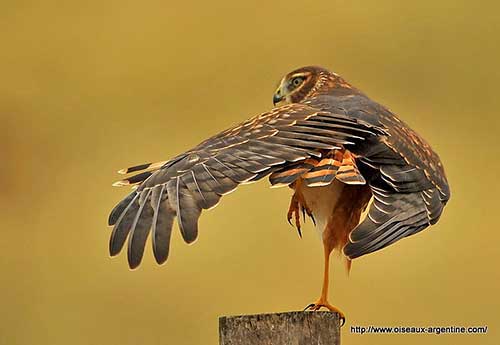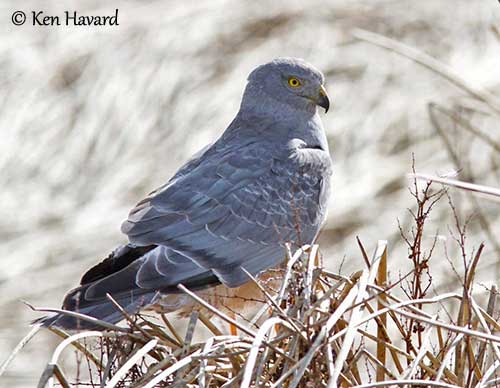
Fr: Busard bariolé
Ang: Cinereous Harrier
All: Grauweihe
Esp: Aguilucho Vari
Ita: Albanella cenerina
Nd: Grijze Kiekendief
Sd: grå kärrhök
Photographers:
Roger Ahlman
Pbase Galleries Peru and Ecuador
John Anderson
John Anderson Photo Galleries
Ken Havard
My Bird Gallery & Flickr gallery 1 & Flickr gallery 2
Eduardo Andrés Jordan
MIS AVES – AVES DE ARGENTINA
Philippe et Aline Wolfer
GALERIE
Text by Nicole Bouglouan
Sources:
HANDBOOK OF THE BIRDS OF THE WORLD Vol 2 by Josep del Hoyo-Andrew Elliot-Jordi Sargatal - Lynx Edicions - ISBN: 8487334156
BIRDS OF PERU by Thomas S. Schulenberg, Douglas F. Stotz, Daniel F. Lane, John P. O’Neill, Theodore A. Parker III – Princeton University Press 2007– ISBN: 978-0-691-13023-1
Birds of Western Ecuador: A Photographic Guide Par Nick Athanas, Paul J. Greenfield – Editeur: Princeton University Press, 2016 – ISBN: 140088070X, 9781400880706
Birds of Ecuador De Robin Restall, Juan Freile - Bloomsbury Publishing, 2019 – ISBN: 147297249X, 9781472972491 - 576 pages
Revista Chilena de Historia Natural
Wikipedia, the free encyclopaedia
Arthur Grosset's Birds (Arthur Grosset)
Birding Patagonia – Adventure expeditions
Global Raptor Information Network - Working to Conserve Birds of Prey in nature
Cinereous Harrier
Circus cinereus
Accipitriformes Order – Accipitridae Family
INTRODUCTION:
The Cinereous Harrier is closely related to both Hen Harrier and Northern Harrier. They were formerly considered conspecific.
The Cinereous Harrier is found in the Neotropical region, from Andes of Colombia and Ecuador to Tierra del Fuego where it occurs in high mountains but also in open areas including savannas, grasslands, lowland marshes and coastal areas in south.
It typically feeds on small mammals (rodents), birds, amphibians, reptiles, large insects and carrion. It nests on the ground among reeds or in grass. This species is territorial.
The Cinereous Harrier is described as fairly common in most of range, with some local declines. The species is not globally threatened for the moment.

DESCRIPTION OF THE BIRD:
Biometrics:
Length: 39-48 cm
Wingspan: 90-115 cm
Weight: M: 315-407 g – F: 427-510 g
The Cinereous Harrier adult male has grey upperparts and upperbreast. The wings have black tips and the rump is white. The rounded tail is barred and tipped black.
On the underparts, lower breast and belly are whitish and conspicuously barred rufous-brown. The underwing is white with black tips to primary flight-feathers, and partial black trailing edge on secondaries and tertials. The undertail is white and barred black.
The head is grey, with indistinct facial disk, less conspicuous than in female.
The bill is blackish with yellow cere. The eyes are yellow. Legs and feet are yellow-orange.
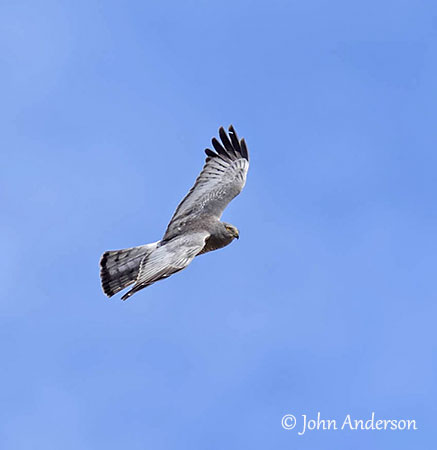
The adult female has dark brown upperparts and white rump. The tail is whitish with four narrow blackish bars and a broader blackish terminal band. We can see a rufous tinge on outermost rectrices.
On the underparts, throat and upperbreast are dark brown, sometimes with white mottling from crown to shoulders, including the nape. Rest of underparts is white with some grey barring on the breast, whereas belly and undertail-coverts are mostly barred chestnut. On the underwing, the coverts are like the belly, and the flight-feathers are barred black and white, like the tail.
She is larger than male. The head is brown with indistinct, short, white eyebrow. We can see an owl-like facial disk, more conspicuous than in male. The bare parts are as in male.
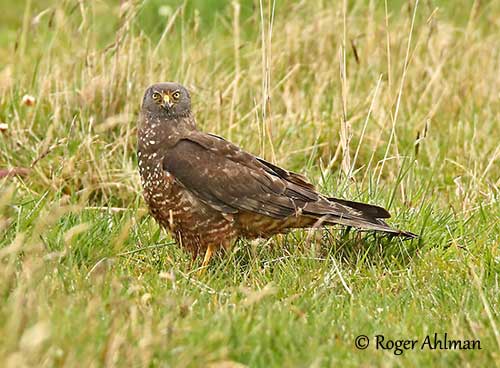
The juvenile resembles female but it has rufous and grey back. A white area is visible at base of the long tail, especially in flight. The underparts are mostly whitish with dark rufous vertical streaks, mainly on breast and flanks. The eyes are reddish-brown instead of yellow.
The young male of second cycle becomes progressively grey above, with white tips to feathers.
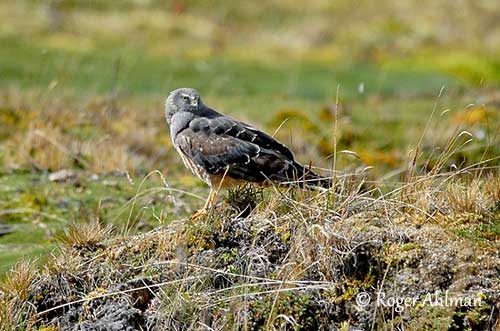
RANGE:
The Cinereous Harrier is found in South America, from Andes of Colombia and Ecuador, and S through Peru (also in coastal areas), and Bolivia to Tierra del Fuego.
Outside breeding season, this species extends its range to Paraguay, NE Argentina and Uruguay. It is considered vagrant in Falkland Islands.
HABITAT:
The Cinereous Harrier may occur in open, grassy habitat and páramo at high elevations, usually the treeline. It can be found in moorlands, marshes and pastures, from sea-level to 4,500 metres in Andean puna. In Central Andes, it frequents high-elevation grasslands, and it is commonly seen near streams and large lakes.
The elevation varies with the latitude, 1,700/3,000 metres in Colombia, above 2,000 metres in Ecuador, and up to 2,000 metres in Patagonia.
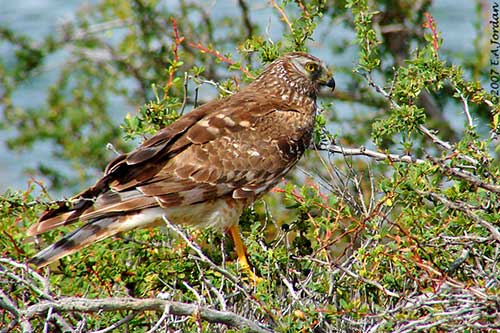
CALLS AND SONGS: SOUNDS BY XENO-CANTO
The Cinereous Harrier is mainly vocal during the breeding season. During the flight displays, the male gives a rapid “kekekekekekek” while the female answers with a softer “chekekekek”. When alarmed, it gives a fast “kikikikikiki” and we can hear a high-pitched whistle “kyeeee” in several situations.
BEHAVIOUR IN THE WILD:
The Cinereous Harrier hunts from dawn to dusk, and usually flies higher during midday. In Tierra del Fuego, it forages in marshes for rodents and lizards, but does not take birds. It usually flies continuously while searching for prey, singly or in pairs. However, they often gather in groups at roosting sites.
It flies low, slowly over the ground, quartering the area in slow zigzag flight in order to flush the birds hidden among the vegetation. It catches them in flight as soon as they flush.
The prey is eaten on the ground. The main prey are birds, small mammals and mainly rodents, amphibians, reptiles and large insects. This raptor perches almost exclusively on the ground, never on trees.
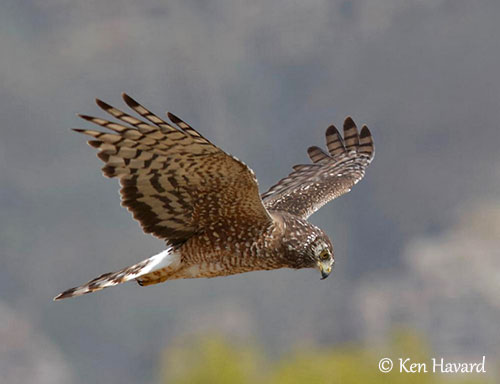
During the breeding season, both mates engage in aerial displays while calling loudly. The male is territorial and may become aggressive towards humans. It hunts and transfers the prey to the female while flying. These prey are used by the female for herself or to feed the young at nest. The nest is on the ground, among reeds and tall grasses. It may be placed at base of shrubs or grasses, both in dry and marshy areas with reeds.
The Cinereous Harrier is resident along the Andean range, from Colombia to Tierra del Fuego and Falkland Islands.
But during the austral winter, it migrates N to northern Argentina, Bolivia, Paraguay and to S Brazil.
The Cinereous Harrier has distinctive, graceful flight during which it performs flapping and gliding low to the ground, often with tilting action side to side, exposing the white rump. The wings are often held in shallow V, making the bird extremely stable.
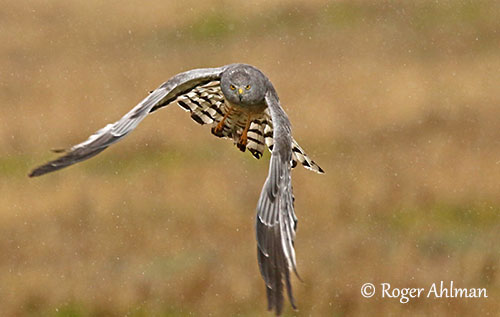
REPRODUCTION OF THIS SPECIES:
The breeding season occurs between October and January in the southern part of the range. This period is closely related to prey abundance for chick feeding.
The Cinereous Harrier nests on the ground, usually among reeds and tall grass. The nest is made with rushes and stems of reeds, and lined with dry grass. The flat, compact structure is built in marshes and pastures, and hidden among reeds, usually 10-30 centimetres above water level.
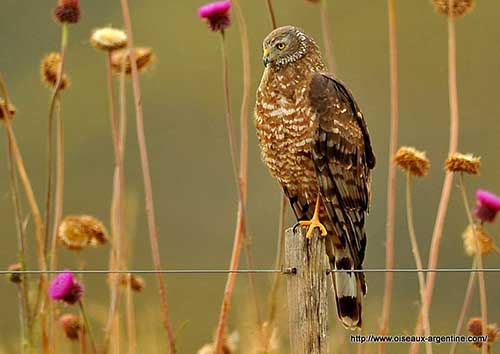
The female lays 4 white eggs and incubates alone. She is regularly fed by the male by transfer of prey in flight. The male calls when it is near the nest with a prey, and the female flies to meet him, while calling too. The prey is seized in the air as soon as the male releases it.
At hatching, the chicks have creamy-white down. They are fed by the female with the food brought by the male.
Several Cinereous Harriers may nest in close proximity, with nests about 25 metres apart. The territory is defended against intruders, including humans.
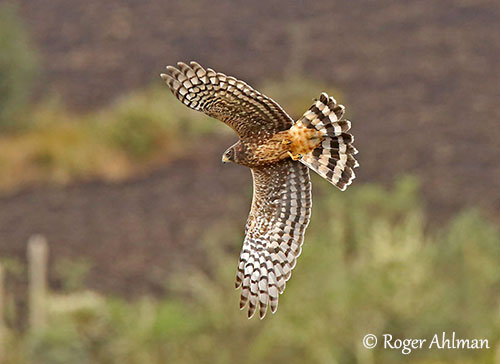
PROTECTION / THREATS / STATUS:
The Cinereous Harrier is fairly common in most of range. Some declines in Chile and Argentina were probably caused by drainage of wetlands and use of pesticides. However, the numbers have increased where the forest has been removed.
The population is estimated to number 12,000/38,000 pairs.
The Cinereous Harrier is not globally threatened and currently evaluated as Least Concern.
